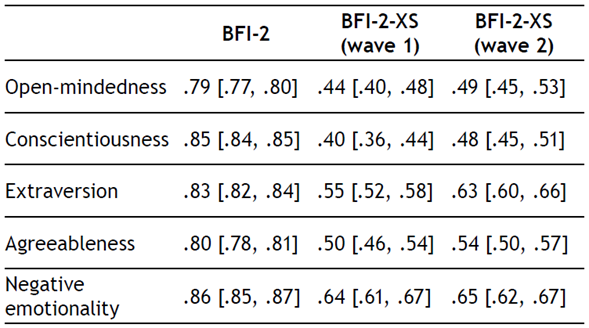Having reliable instruments to measure personality is a necessity. The ability to predict behaviours in individuals is enhanced by standard procedures for quick identification of general patterns of cognitive, emotional, and behavioural response consistent throughout time and contexts. Being such an important construct in psychology, having a variety of options for the measurement of personality is a requirement for follow-up, confirmation of results, comparison between different metrics, etc. Worldwide, there is a substantial variety of instruments for this purpose, many of them based on the general theory of personality traits and developed following the Big Five Factor Model (BFFM), which has come to be considered the most reliable model of personality (Digman, 1990; Maples-Keller et al., 2019). However, in Mexico, there is a rather short supply of alternatives for the measurement of personality, and an even scarcer stock of more recent instruments based on the BFFM (Reyes Zamorano et al., 2014) as is the case in other Latin American countries (for examples, see: Fernando et al., 2021; Genise & Ungaretti, 2020; Veloso Gouveia et al., 2021). In this study, we aimed to address this issue by providing evidence of validity of a recent scale based on this model of personality: the Big Five Inventory-2 (BFI-2, Soto & John, 2017b).
The BFI-2 clusters traits into the known big five domains and proposes three new distinct facets for each of them: Open-mindedness (Intellectual curiosity, Aesthetic sensitivity, Creative imagination), Conscientiousness (Organisation, Productiveness, Responsibility), Extraversion (Sociability, Assertiveness, Energy level), Agreeableness (Compassion, Respectfulness, Trust), and Negative emotionality (Anxiety, Depression, and Emotional volatility) (Soto & John, 2017b). This inventory was developed to solve several limitations of the original BFI by achieving the following features: robust hierarchical structure (three facets for each of the five factors); minimised influence of acquiescent responding (by balancing the number of true-keyed versus false-keyed items); satisfactory balance between bandwidth and fidelity (both factors and facets proved satisfactory predictive capacity, with the latter being more specific); and focus, clarity and brevity in its items (Soto & John, 2017b). The BFI-2 has three versions with 60, 30, and 15 items respectively (BFI-2 Extra Short Form (BFI-2-XS)). Overall, there seems to be enough information for considering each and every version as a potentially useful alternative measure of personality (see Instruments), and evidence of their cross-cultural validity has been gathered in multiple samples (Denissen et al., 2020; Halama et al., 2020; Rammstedt et al., 2020; Zhang et al., 2022). The BFI-2, both in its longest and shortest versions, can provide benefits for psychologists working with Mexican individuals. The primary set of objectives for the current study is thus to analyse the basic measurement properties (internal consistency, retest reliability, and nomological validity) of the Spanish-translated versions of the BFI-2 and the BFI-2-XS, and to test the replication of the BFFM in both versions.
Besides this transcultural validity, one important unexplored property of the BFI-2 concerns its interpretability based on a person-centred approach rather than a variable-centred one. As with all common measurements of personality, the BFI-2 provides scores for each of its factors, rendering a unique profile of the respondent. Each of these factors is then associated to significant life outcomes, most often in the form of bivariate correlations (e.g., less Negative Emotionality predicts higher psychological well-being) but also through multivariate analyses (e.g., psychological well-being is best predicted by lesser Negative Emotionality and higher Conscientiousness and Extraversion). This can become a problem of limited parsimony due to the extended number of distinct profiles (in theory, a single profile per individual), which are difficult to interpret because of the complexity. There have been attempts (Fisher & Robie, 2019; Isler et al., 2017; Specht et al., 2014) to produce empirically derived personality profiles based on the application of latent profile analysis, which makes possible the identification of homogenous subgroups based on the responses of individuals. To our understanding, the study by Fisher and Robie (2019) is the most parsimonious and useful in terms of theoretical interpretation and predictive capacity. These authors found that a three-profile solution quantitatively differentiated by levels of adaptability (low, normal, and high) to social environment predicts relevant outcomes for network size, job self-efficacy, values, and satisfaction with life. Identifying these latent profiles with the longest and shortest versions of the BFI-2, and testing their nomological validity, may increase its utility for psychology professionals, providing them with a succinct interpretation of individuals’ results, and this pertains to the second set of objectives of the study.
Overall, we believe that the findings of our study could provide evidence for the introduction of a new measurement of personality to be used for the Mexican population, serving as an alternative to other instruments that are currently available, for different clinical or research purposes such as comparing metrics, controlling for habituation effect when repeating assessment with a single scale, interpreting measurements of traits through the lens of latent profiles, using an alternative set of facets to the main Big Five factors, or having the option of quick explorations with the BFI-2-XS.
Method
Participants
A two-wave non-probabilistic sample was recruited by means of chain referral via social networks. Eligibility criteria were based on participant’s self-report and comprised: being 18 years-old or more, being Mexican, and providing informed consent. Collection of baseline data began in March 2020 and extended to November 2020. Follow-up began in September 2020 and ended in January 2021, procuring at least three months of in-between measures for each participant.
Instruments
Demographic questionnaire. It included items referring to sex (male, female), age (six ordinal levels from 18 to 61 or higher), educational attainment (six groups from no degree to post-graduate, considering completed degrees or being in the last year for completion), and self-reported socioeconomical status (low, middle, or high).
Demographics were used to test the nomological validity of the BFI-2 and the BFI-2-XS; for example: between-sex differences in Negative Emotionality and Agreeableness, age-related increases in Agreeableness and Conscientiousness, and decreases in Negative Emotionality.
Big Five Inventory-2 (BFI-2) and Big Five Inventory-2-Extra Short Form (BFI-2-XS). The BFI-2 measures the personality according to the BFFM. For this study, we employed the 60-item version for baseline data collection, and the extra-short form of 15 items for the follow-up. These self-report inventories ask the respondent to assess their personality according to short statements (e.g., “I’m a person who is talkative”) with a 5-point scale (from “Disagree strongly” to “Agree strongly”). For both the BFI-2 and the BFI-2-XS, five scores corresponding to each of the personality factors are computed using 12 and 3 distinct items, respectively, for each of them; for the BFI-2, three sub-scores corresponding to each of the facets can also be computed. Higher scores indicate a greater tendency toward that personality trait (e.g., higher values of Conscientiousness indicate propensity to orderliness, industriousness, and dutifulness, whereas higher values of Negative Emotionality indicate propensity to anxiety, depression, and lability).
Confirmatory factor analyses performed on the 60-item version of the BFI-2 show acceptable goodness-of-fit, especially when adding a method factor to control for acquiescence responding (comparative fit index >.90; Tucker-Lewis index >.90; root mean square error of approximation <.08). The BFI-2 also displayed acceptable internal consistency (alpha ~.84 for the domain level and ~.75 for the facet level), satisfactory self-peer agreement (correlations averaging .56 and .32 for domain and facet levels, respectively), discriminant validity (correlations averaging .11 for domains), acceptable reliability (average correlation of .80 for domains), and consistent nomological network with other classical measures of the BFFM (Soto & John, 2017b). For its part, throughout different samples, the BFI-2-XS has proven moderate internal consistency, with Cronbach’s α ranging from .55-.73 for the factor level in the original validation (Soto & John, 2017a), .56-.72 in a Dutch adaptation (Rammstedt et al., 2020), and .50-.72 in a Slovak adaptation (Kohút et al., 2020), and moderate associations with measures of well-being (r between .13-.38) in the Dutch adaptation (Rammstedt et al., 2020); and between .13-.49 in the Slovak adaptation (Kohút et al., 2020).
The Spanish-translated items of the BFI-2 were provided by one the authors of the original validation and, at the moment of writing this paper, are accessible as a preprint version (Gallardo-Pujol et al., 2022).
Quality of Life Enjoyment and Satisfaction Questionnaire-Short Form (Q-LES-Q-SF). In the current study, the Q-LES-Q-SF was included only in the baseline data to test the nomological validity of the BFI-2 for each of its domains (e.g., positive association with Conscientiousness, and negative association with Negative Emotionality) and latent profiles (positive association with higher categories of adaptability). This scale consists of 15 items that evaluate self-reported quality of life in the following domains: physical health, subjective feelings, leisure activities, social relationships, general activities, and life satisfaction (an additional item exploring satisfaction with medication is optional and was not considered for the present study). This shorter version of the instrument was preferred over the original one in order to reduce friction to respond to the online survey.
Responses are scored on a 5-point scale (“Not at all or never” to “Frequently or all the time”). Two main outcomes are considered: the global score computed by the addition of items 1 to 14 (range: 14-70), and the value of item 15, which examines overall satisfaction with life. Higher values in both outcomes indicate a better quality of life. The mean global score in the original validation of this instrument was 37.27, and 6.34 points has been suggested as the smallest detectable change in follow-up comparisons (Stevanovic, 2011). We will use this last value to compare and interpret the mean quality of life reported within our sample.
We employed a Spanish-adapted version of the scale that has been utilised with the Mexican population (Armas Castañeda et al., 2010). In its original validation, the Q-LES-Q-SF proved good internal consistency (Cronbach’s alpha = .90) and test-retest reliability (r = .93) in its original validation (Stevanovic, 2011).
Procedure
For the collection of baseline data, three versions of the online survey were created in Google Forms, differentiated only by the sequence of the instruments, in order to control for possible between-measures effects. The links were independent. Specifically, we employed the Facebook service for advertisement in several key states of the Mexican Republic (Baja California, Chihuahua, Guadalajara, Nuevo León, Mexico City, State of Mexico, Veracruz, and Quintana Roo), and performed manual advertisement through this same social network as well as WhatsApp, starting with the pages and contacts of the researchers.
The individuals who open the links were presented with the informed consent and requested to check box for comprehension and acceptance. Participants were informed that all the questions required obligatory response (meaning that the survey would not allow sending if one or more items were unanswered), except for demographic items which included the option “I prefer not to answer”. Before displaying the option to end and send the survey, participants were asked if they would like to receive a summary of their results, and if they would want to participate in a follow-up of the survey. For either option, they were asked to provide an email address.
For the follow-up, an email invitation was sent a maximum of twice to each of the participants in case of not responding to the first invitation. This follow-up survey was also designed using Google Forms and contained the informed consent and the BFI-2-XS.
Statistical analysis
Descriptive analyses included mean and standard deviation for numerical variables, and frequencies and percentages for categorical variables. Tests of statistical differences (Student’s t and ANOVA) of the BFI-2 scores relative to sociodemographics were performed for exploring nomological validity (e.g., commonly known differences in Agreeableness between genders, or regarding Conscientiousness between age groups). Bivariate correlations using Pearson’s coefficient were conducted between factors and facets of the BFI-2, between factors of the BFI-2-XS, between these measures and the Q-LES-Q-SF, and to examine the test-retest reliability of the BFI-2-XS. Student t and One-way ANOVA were employed in this study because they are robust to violations of the normality when the sample size is large (>500) (Posten, 1984). These basic statistics were rendered using JASP version 0.14.1 (JASP Team, 2020).
Confirmatory factor analysis (CFA) was carried out using weighted least squares with adjusted mean and variance estimator, and items were considered as ordinal indicators. We specified four models of each factor, single domain, single domain with plus acquiescence, three facets, and three facets plus acquiescence models according to the original validation of the BFI-2 (Soto & John, 2017b). Once selected the model with better fit, we extracted latent scores and used them as indicators in a latent class profile (LCP). We conducted CFA and LCP analysis using Mplus 8.7. As a final step we extracted the most probable latent profile and used it in a one-way ANOVA to compare differences in overall life satisfaction.
Results
Descriptive statistics and differences relative to demographics
A total of 2,074 observations were originally registered in the database of the survey. From these, 49 duplicate cases were removed, ending with a baseline sample of 2,025 complete primary responses to the BFI-2. Unanswered items were found in all demographics, and they are reported on Table 1. For the follow-up, a total of 666 observations were originally registered, but 29 were removed due to duplicity, and 27 due to the impossibility of matching with the baseline case (because of participants providing a different email address), leaving 610 with complete responses to the BFI-2-XS. There was no missing demographic data in the follow-up.
Table 1 Descriptive analysis for demographics, personality, and other variables of interest
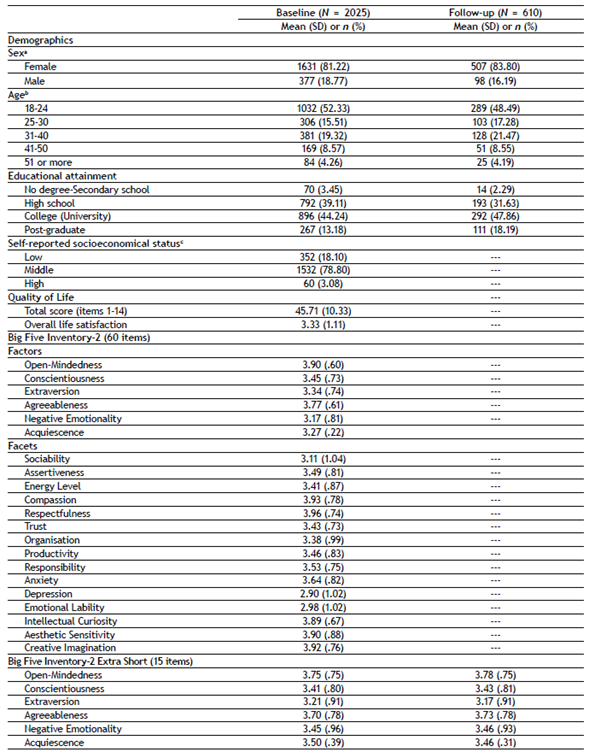
Note. a Not answered = 17; b Not answered = 53; c Not answered = 81
As observed on Table 1, for both the baseline and the follow-up, approximately 82% of the sample were female between 18 and 30 years of age (~66%) with a high school-to-college education (~81%), and mainly middle-income earners (79%) according to their self-evaluation. The mean global score of the Q-LES-Q-SF was significantly higher than in the original validation of the instrument (2.1 points above the proposed score for smallest detectable change), and the average value of overall life satisfaction (item 15) was only slightly higher than that reported in this original validation (Stevanovic, 2011).
All the main factor scores of the BFI-2 proved a negative distribution (particularly Open-mindedness (skewness = -.41) and Agreeableness (skewness = -.61)), proving non-normality according to the Shapiro-Wilk test. The same pattern was observed for the BFI-2-XS in the follow-up. Significant between-group differences with small-to-moderate effect sizes were observed for: (a) Negative emotionality within gender (t(2006) = -9.19, d = -.52), age (F(4, 1967) = 39.18, η² = .07) and education (F(3, 2021) = 21.66, η² = .04), showing higher scores in women, younger individuals and lower degrees of education; (b) Conscientiousness and Extraversion both within age (F(4, 1967) = 50.08, η ²= .09; F(4, 1967) = 39.94, η² = .07) and education (F(3, 2021) = 34.46, η ²= .04; F(3, 2021) = 32.07, η² = .04), with higher scores as age and education increased; and Agreeableness within gender (t(2006) = -3.52, d = -.20), favouring women for higher scores. Paired samples t-test proved no difference between baseline and follow-up regarding the scores of the five factors of the BFI-2-XS within these demographics.
Confirmatory factor analyses
As can be seen on Table 2, for Open-mindedness, Conscientiousness, Extraversion and Negative emotionality, the best-fitted models were the ones composed of three facets plus acquiescence (CFI ≥ .95, TLI ≥ .95), but with barely satisfactory RMSEA values. Referring to these factors, the models fitted well considering the CFI and the TLI, though fitted poorly regarding the RMSEA. Agreeableness approximated the minimum criteria for goodness-of-fit only in the model with three facets plus acquiescence.
Table 2 Fit Statistics for the Confirmatory factor analyses of the BFI-2 (60-Items version)
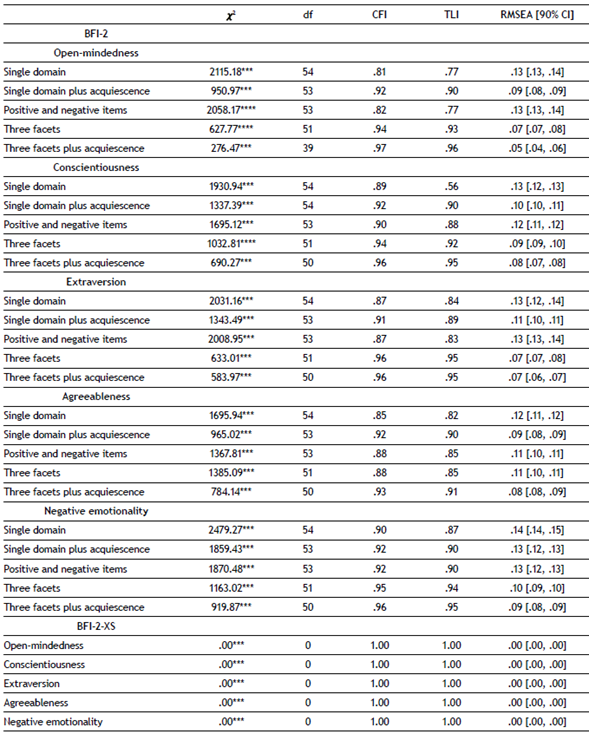
Note. df = degrees of freedom; CFI = comparative fit index; RMSEA = root mean square error of approximation; TLI = Tucker-Lewis Index.
* p < .05; ** p < .01; *** p < .001
For its part, the BFI-2-XS proved excellent goodness-of-fit for all the general factors in both baseline and follow-up measures.
Reliability
Considering a 95% confidence interval, the values of test-retest analysis for the BFI-2-XS were as follows: Open-mindedness: r = .66(.61, .70); Conscientiousness: r = .69(.64, .72); Extraversion: r = .77(.73, .80); Agreeableness: r = .74(.70, .77); Negative emotionality: r = .73(.69, .76); Acquiescence: r = .14(.06, .21). Analysis of internal consistency of the BFI-2 proved satisfactory values for the general factors (Table 3).
Bivariate correlations
Associations between factors of the BFI-2 were overall low-to-moderate (r ranging from .22 to .50), but lower (r < .22) with regards to Open-mindedness (Table 4). Between-facets associations (Supplementary Table 1) within respective factors proved to be generally moderate, and slightly stronger (r ranging from .51 to .66) for the facets composing Conscientiousness and Negative emotionality. Concerning these last results, other between-facets moderate correlations were found outside respective factors, particularly Assertiveness in relation to Creative imagination, Productivity, Responsibility and Depression; and the facets Depression and Emotional volatility with regards to: Organisation, Responsibility, and Energy level. With regards to the BFI-2-XS, intercorrelations were moderate-to-low (r between -.31 and .12) for all the factors.
Table 4 Correlation analyses between BFI-2 factors and Q-LES-Q-SF Scores (N = 2025)
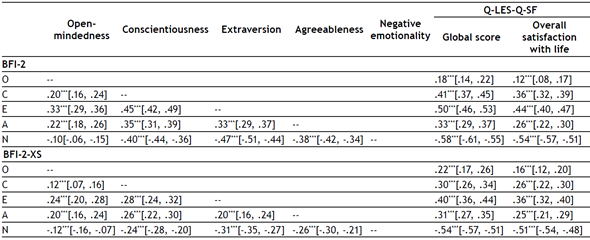
Note. BFI-2 = Big Five Inventory, 60-items version; BFI-2-XS = Big Five Inventory, 15-items version; Q-LES-Q-SF = Quality of Life Enjoyment and Satisfaction Questionnaire-Short Form.
Confidence intervals at 95% are indicated between brackets.
* p < .05. ** p < .01. *** p < .001
Using the baseline measurement, all the factors correlated significantly with the results of the Q-LES-Q-SF, especially Negative emotionality, Extraversion and Conscientiousness (r ranging from -.54 to .50). These correlations are also significant in the BFI-2-SX, but with lower magnitudes. Open-mindedness proved low values of correlation with quality of life (r ranging from .12 to .22) in both versions of the inventory.
Latent profile analysis
As shown on Table 5, the models with five to seven profiles proved better goodness-of-fit. We decided to retain the five-profile solution since the subsequent models proved local maxima, and because the proportion of individuals was more balanced between the five subgroups.
Table 5 Fit indices for the latent profiles

Note. AIC = Akaike information criterion; BIC = Bayesian information criterion; VLMR = Vuong-Lo-Mendell-Rubin test; LMR = Lo-Mendell- Rubin test; BLRT = bootstrap likelihood ratio test.
Using the BFFM metafactors of Plasticity (Extraversion and Open-mindedness), and Stability (Conscientiousness, Agreeableness and Negative emotionality) (van der Linden et al., 2010) so as to concisely summarise the results of this analysis, the profiles (P) could be labeled as follows: P1) Average Stability/Plasticity; P2) Low Stability/High Plasticity; P3) High Stability/Low Plasticity; P4) High Agreeableness/Low Open-mindedness; P5) Low internal instability (Figure 1). Latent values of Conscientiousness were homogeneous for all the subgroups, so this factor was not considered for their distinction.
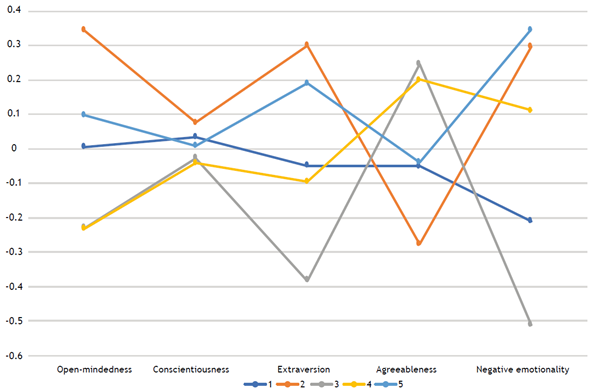
Note. N = 2025. Individuals per profile (P): P1 = 985; P2 = 150; P 3= 159; P4 = 303; P5 = 428.
Figure 1 Latent profiles extracted from the Big Five Inventory-2 (60 Items)
Between-groups differences examined with ANOVA proved statistical significance (F(4, 2020) = 179.87, p < .001, η² = .26) relative to the total score of the Q-LES-Q-SF, with the following means (and standard deviations): P1 = 46.34(9.1), P2 = 34.59(7.4), P3 = 49.56(9.1), P4 = 56.14(8.05), P5 = 38.89(8.89). These differences were also observed in relation to overall life satisfaction (F(4, 2020) = 139.22, p<.001, η² = .21): P1 = 3.43(.98), P2 = 2.21(.94), P3 = 3.7(1.0), P4 = 4.26(.69), P5 = 2.6(1.08). Overall, P4, P3 and P1 showed, in descending order, higher values of subjective quality of life, whereas P5 and P2 showed the lowest ones. Post-hoc Bonferroni tests proved statistical differences between all profiles.
Discussion
The first main goal of our study was to analyse the psychometric properties of the BFI-2 (60 items) and the BFI- 2-XS (15 items), including their factorial structure, in a sample of Mexican individuals. Concerning the CFI of the BFI-2, we found that both the models of three facets, and three facets plus an acquiescence method factor, showed the best goodness-of-fit values. These results are similar to those reported by Soto and John (2017b) and a validation of this inventory in a Slovak sample (Halama et al., 2020). The models with a single domain plus acquiesce proved to be unsatisfactory according to cutoff scores recommended for CFA (Hu & Bentler, 1999), though the values in our samples were higher than those reported in the original and Slovak validations. Our findings suggest that the most accurate way to interpret the results of the BFI-2 is by considering it as 15-faceted scale. The BFFM can still be employed for summary interpretations, albeit by accepting an important margin of error.
Temporal consistency could only be performed with the BFI-2-XS (the 15 items extracted from the complete BFI-2 for the baseline), proving acceptable test-retest values, similarly to its original validation (Soto & John, 2017a).
Regarding nomological validity, we found high correlations of the factors with both Q-LES-Q-SF measures. Specifically, the higher association was for Negative emotionality with both Q-LES-Q-SF scores (being and inverse correlation), followed by Extraversion, Conscientiousness and Agreeableness, in positive directions. These results were consistent with the original validation of the BFI-2 (Soto & John, 2017b) and the Dutch (Rammstedt et al., 2020) and ( Slovak Kohút et al., 2020) validations of the BFI-2-XS using other closely related measures of life satisfaction. The results were similar even with regards to Openness, which associated poorly with these measures. Overall, it seems to indicate that both the BFI-2 and the BFI-2-XS are acceptable predictors of subjective measures of quality of life. Besides, typical correlations with sociodemographics were found, adding to the nomological validity of this Spanish-translated version of the BFI-2. For example, higher Agreeableness and Negative emotionality was observed in women, and a greater tendency towards Conscientiousness and emotional stability were also observed in positive relation to age; both findings are common within the personality literature (Schmitt et al., 2017; Soldz & Vaillant, 1999).
Concerning the latent profiles, we found that five profiles proved to be the better solution in terms of goodness-of-fit values and proportion of individuals between each group. Labelling of these profiles, however, was not an easy endeavour, since the found patterns were very heterogeneous, in stark contrast with those found by Fisher and Robie (2019) which formed an intensity-based differentiation (low to high adaptability). This substantial difference is explained by the use of latent scores rather than sum scores for the analysis, accounting for measurement error. A first implication of our finding could be that latent profiles based on the BFFM display qualitative and quantitative differences dissimilarly to those reported in previous literature, which found only quantitative differences (Fisher & Robie, 2019; Specht et al., 2014). As stated before, we used the BFFM metafactors of Plasticity (Extraversion and Open-mindedness), and Stability (Conscientiousness, Agreeableness and Negative emotionality) (van der Linden et al., 2010) to summarise the results of this analysis. According to our results, personality profiles characterised by High Agreeableness/ Low Open-mindedness, High Stability/Low Plasticity, and Average Stability/Plasticity, showed the better scores of subjective quality-of-life, whereas profiles of Low internal instability and, mainly, Low Stability/High Plasticity, registered lower scores. These results are overall consistent with the literature regarding quality-of-life and the BFFM; e.g., negative correlation between Negative emotionality, and positive correlations with the other factors (Fisher & Robie, 2019; González Gutiérrez et al., 2005).
One interesting feature regarding the complexity of our study is that individuals with high plasticity (greater tendency towards Open-mindedness and Extraversion) and low emotional instability obtained the lowest values of quality-of-life, perhaps because Extraversion and Open-mindedness are only predictors of positive outcomes when there is emotionally stability, but both can work as negative predictors when emotional instability is the main feature (the “cursed artist” stereotype). In a more theoretical sense, this finding suggests that only an intensity-based profiling may not provide a sufficient account of personality, as proposed by Fisher and Robie (2019).
We used an online survey to reach a wider representation of individuals from different states of the Mexican Republic, but this method had considerable limitations. First, the sample was non-probabilistic, limited by access to the Internet, and thus indicative of a possible better socioeconomic status than the general Mexican population, since most individuals within the country do not have easy access to Internet (De Tuya & Schurr, 2017). Socioeconomic status has been associated with Negative emotionality and Conscientiousness (McCann, 2011) and therefore the observed scores in our sample could have been biased by this demographic tendency. Also, most of the sample was composed of women, possibly biasing the factors of Agreeableness and Negative emotionality toward higher values, since these traits are at least mildly higher in women (Schmitt et al., 2017) (in fact, Agreeableness could explain the proclivity of women to answer online surveys). However, the facts that we also collected a non-negligible sample of men (n = 377), that we found a similar factorial structure than that reported with more gender-balanced samples (Halama et al., 2020; Soto & John, 2017b), and that we found associations between the Big Five factors and demographics, provide evidence that both versions of the inventory behave within our sample as they do in other populations. Besides, both the BFI-2 and the BFI-2-XS have been previously validated with online samples (Halama et al., 2020; Rammstedt et al., 2020; Soto & John, 2017b), obtaining similar results.
Another important limitation was the fact that we did not administer the BFI-2 in the follow-up. This decision was taken so as to reduce friction to responding to the survey for a second time, because, by the time we planned to collect the follow-up data, the COVID-19 pandemic had been ongoing for six months, and several online surveys were making their rounds in the social networks. We tried to compensate for this limitation by conducting the test-retest analysis with the BFI-2-XS, extracting its 15 items from the BFI-2 administered in baseline, and with data from the administration of the BFI-2-XS in the follow-up survey.
We found the psychometric properties of the BFI-2 and the BFI-2-XS similar to those reported in previous studies. As far as our findings go, we recommend the use of the BFI-2 as a measure of personality facets rather than one of personality factors, in order to reduce measurement error. Our study is the first to provide evidence of validity of the BFI-2 in Mexican individuals, and to introduce this instrument to psychology practitioners to aid them in quickly identifying general patterns of cognition, emotion, and behaviour in practical or research settings. Future studies should test this instrument with non-Internet samples, and with more balanced demographics, particularly concerning gender and socioeconomical status. Finally, further examination of latent profiles is needed to corroborate our findings, particularly comparing differences between countries in the composition of the social classes.














